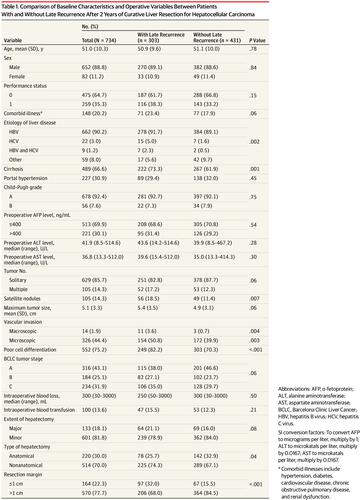当前位置:
X-MOL 学术
›
JAMA Surg.
›
论文详情
Our official English website, www.x-mol.net, welcomes your feedback! (Note: you will need to create a separate account there.)
Risk Factors, Patterns, and Outcomes of Late Recurrence After Liver Resection for Hepatocellular Carcinoma: A Multicenter Study From China.
JAMA Surgery ( IF 16.9 ) Pub Date : 2019-03-01 , DOI: 10.1001/jamasurg.2018.4334 Xin-Fei Xu 1, 2 , Hao Xing 1 , Jun Han 1 , Zhen-Li Li 1 , Wan-Yee Lau 1, 3 , Ya-Hao Zhou 4 , Wei-Min Gu 5 , Hong Wang 6 , Ting-Hao Chen 7 , Yong-Yi Zeng 8 , Chao Li 1 , Meng-Chao Wu 1 , Feng Shen 1 , Tian Yang 1
JAMA Surgery ( IF 16.9 ) Pub Date : 2019-03-01 , DOI: 10.1001/jamasurg.2018.4334 Xin-Fei Xu 1, 2 , Hao Xing 1 , Jun Han 1 , Zhen-Li Li 1 , Wan-Yee Lau 1, 3 , Ya-Hao Zhou 4 , Wei-Min Gu 5 , Hong Wang 6 , Ting-Hao Chen 7 , Yong-Yi Zeng 8 , Chao Li 1 , Meng-Chao Wu 1 , Feng Shen 1 , Tian Yang 1
Affiliation

|
Importance
Late recurrence (more than 2 years) after liver resection for hepatocellular carcinoma (HCC) is generally considered as a multicentric tumor or a de novo cancer.
Objective
To investigate the risk factors, patterns, and outcomes of late recurrence after curative liver resection for HCC.
Design, Setting, and Participants
This study was a multicenter retrospective analysis of patients who underwent curative liver resection for HCC at 6 hospitals in China from January 2001 to December 2015. Among 734 patients who were alive and free of recurrence at 2 years after resection, 303 patients developed late recurrence. Data were analyzed from June 2017 to February 2018.
Interventions
Liver resection for HCC.
Main Outcomes and Measures
Risk factors of late recurrence as well as patterns, treatments, and long-term outcomes of patients with late recurrence. Univariate and multivariate Cox regression analyses were performed to identify independent risk factors of late recurrence.
Results
Of the included 734 patients, 652 (88.8%) were male, and the mean (SD) age was 51.0 (10.3) years. At a median (interquartile range) follow-up of 78.0 (52.8-112.5) months, 303 patients (41.3%) developed late recurrence. Multivariate analysis revealed that male sex, cirrhosis, multiple tumors, satellite nodules, tumor size greater than 5 cm, and macroscopic and microscopic vascular invasion were independent risk factors of late recurrence. Of the 303 patients with late recurrence, 273 (90.1%) had only intrahepatic recurrence, 30 (9.9%) had both intrahepatic and extrahepatic recurrence, and none had only extrahepatic recurrence. Potentially curative treatments were given to 165 of 303 patients (54.5%) with late recurrence, which included reresection, transplant, and local ablation. Multivariate Cox regression analysis showed that regular surveillance for postoperative recurrence (hazard ratio [HR], 0.470; 95% CI, 0.310-0.713; P = .001), cirrhosis (HR, 1.381; 95% CI, 1.049-1.854; P = .02), portal hypertension (HR, 2.424; 95% CI, 1.644-3.574; P < .001), Child-Pugh grade of B or C (HR, 1.376; 95% CI, 1.153-1.674; P < .001), Barcelona Clinic Liver Cancer stage B (HR, 1.304; 95% CI, 1.007-1.708; P = .04) and stage C (HR, 2.037; 95% CI, 1.583-2.842; P < .001), and potentially curative treatment (HR, 0.443; 95% CI, 0.297-0.661; P < .001) were independent predictors of overall survival for patients with late recurrence.
Conclusions and Relevance
Late recurrence after HCC resection was associated with sex, cirrhosis, and several aggressive tumor characteristics of the initial HCC. The patterns of late recurrence suggested surveillance for recurrence after 2 years of surgery should be targeted to the liver. Postoperative surveillance improved the chance of potentially curative treatments, with improved survival outcomes in patients with late recurrence.
更新日期:2019-03-21



























 京公网安备 11010802027423号
京公网安备 11010802027423号